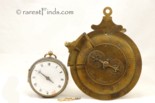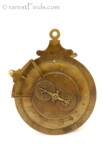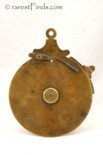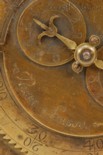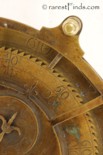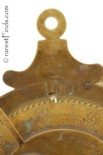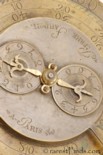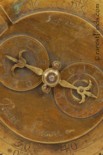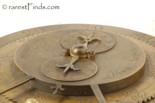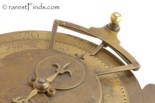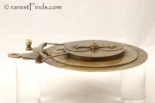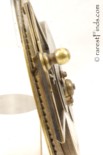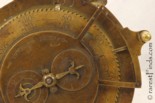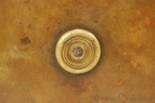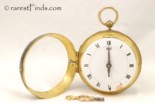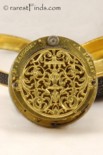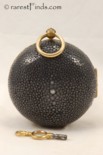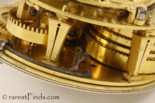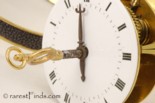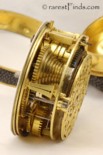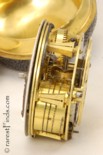The Adding Machine of Pierre Fardoil c. 1700. Price, $73,500.
Very early antique adding machine for adding and subtracting numbers from 0-100 in the shape of an astrolabe. The machine - signed "Pierre Fardoil à Paris" is hand-crafted in brass and steel, measures 5-1/2 inches in height and is in perfect working condition. Traces of silver indicate that this fine instrument was originally silvered.
Fardoil's contribution to the development of mechanical calculating devices is the introduction of his mechanism which enables the operator to read the result without counting the dividing marks on a circular scale of a disc shaped adding machine. Fardoil achieved this improvement by utilizing a planetary gear turning two round scales underneath two stationary hands ten times over the entire range of the antique historic adding machine. The two scales show the numbers from 0-9 for additions and for subtractions respectively. This simple use of a planetary gear enabled Fardoil to provide a read-out in the range of numbers between 0-100 without the need of a carry-over from 9 to 10, 20, 30, etc.
To read the instructions how to operate this antique adding machine which could also be used to subtract click here!
Unlike the very early calculators by Schickard, Leibniz, Pascal, Grillet, and others, Fardoil's adding- and subtracting-machine was a true "pocket calculator" as it is flat and would fit in any pocket.
Condition:
This exceedingly early antique calculator is in the condition as it was found with the exception of the replaced two flat steel springs which became a victim of oxidation over the last 300+ years. The springs have been replaced by distinguished watch maker Paul Gerber in Zurich Switzerland.
Signs of silver on the surface is an indication that this instrument was silvered when it left Pierre Fardoil's shop at Place de Dauphine in Paris more than 300 years ago. This antique calculator is in perfect working order, its operation smooth and exact.
History:
Calculators manufactured by hand before mass-production, which started around 1875, are extremely scarce; there are less than ten other models of calculators known which were invented or made before circa 1700. Fardoil invented his adding machine approx. 80 years before the French Revolution! King Louis XVI (1774-1792) — executed in 1793 — was not even born when Fardoil invented his adding machine. Louis XVI was born only about 50 years later, in 1754. Pocket watches were already made in limited numbers as there was the need to know time and pocket watches were a status symbol at the time for the few who could afford them.
The Fardoils were a watch-making dynasty. Pierre Fardoil was one of the sons of Pierre Fardoil senior from Blois, France, who died in 1669. Fardoil became a registered master watchmaker in 1684. He was a Huguenot (French Protestant) and fled France for London due to religious persecution; there he worked under the name Peter Fardoil. Some of his inventive work signed "Peter Fardoil" is part of the collection of the British Museum, (museum #1958,1201.23471958,1201.2347).
The revocation of the Edict of Nantes in 1685 caused the Huguenots, mostly protestants, to lose their civil rights and many escaped to neighboring countries as refugees. Around 1700 Fardoil returned to France and set up his workshop at the Place Dauphine in Paris as watchmaker for King Louis XIV 1643-1715, (mâitre horloger du Grand Conseil du Roy). King Henry IV, father of King Louis XIII (1610-1643), named this place after his son who was also called la Grand Dauphine.
Remarkably, Place Dauphine was built for the emerging merchant class to purchase, rather than the elite classes like Henri IV‘s other notable civic project Place des Vosges. The properties were quickly bought up by scientists and goldsmiths who built laboratories and shops. All leading advances were discovered here; alchemy, medicine, science, photography, watch making and more. Marie Antoinette and Napoleon bought the first Piguet watches here in their shop. No wonder that Pierre Fardoil chose the place to setup shop to create his innovative clocks, watches, and other instruments such as his adding machine offered here.
The print on the right is a "vue d'optique" or "perspective view" to be viewed by a Zograscope. The Zograscope was first mentioned or described by John Dee in 1570; it is an optical viewer consisting of a large magnifying lens in front of an angled mirror which reflects the image of a print, a vue d'optic, laid flat on the table underneath the mirror. As the print viewed through the magnifying glass and mirror, the viewer would get the sensation of depth of the scene on the print. A vue d'optique is recognizable as the writing identifying the scene is also written backwards or as a mirror image on top of the vue or print. The vue d'optique on the right shows the writing "Place Dauphine a Paris" as a mirror image on top of the print.
I included this image here to show the reader how old this antique Adding Machine invented by Pierre Fardoil actually is. At the time, you could count the adding machines allready invented on one hand!
The print shows interesting details; on each side in the print is a lamp-post with a whale oil lamp illuminating the stairs at night for safety. Large cities like Paris, London, and many others, already had street lighting. The immense need for whale-oil almost extinct whales in the 19th century.
The two horse drawn coaches on the cobblestone roadway just passed each other driving on the left. The drivers would hold their whips in their right hand and pass on the left in order to prevent whipping ladys hats from their heads while they where walking on each side of the road-way.
Fardoil died in 1722. Among many ingenious designs, Fardoil also invented his famous dividing engine for wheels with 102 to 800 teeth, built an astronomical pendulum clock for King Louis XIV the Great, also called the Sun King (1643-1715), and built many pocket watches which were characterized by novel and unusual features. Fardoil is known as the first watchmaker to create full-enamel dials, as the dial on the pocket watch included here. His valuable clocks and pocket watches are today part of famous museums such as the "Musée de l'Observatoire", the "Musée des Arts et Metiers" (both in Paris), "Musée International d'Horlogerie La Chaux-de-Fonds", Switzerland, and the "British Museum", in London, which has in its collection a pocket watch dated c. 1700. Fardoil's pocket watches are also to be found among important private collections. The astronomical pendulum clock survived to this day and is part of the collection of the "Musée de L'Observatoire", Paris, exhibited at the Château de Meudon,(Louis XIV, Le Grand Dauphin, died there in 1715.)
The other example of Fardoil's adding machine known to exist and mentioned above was donated to the "Musée des Arts et Metiers, Paris" in 1866 by the French "Académie des Sciences." However, this second example mysteriously vanished or can not be found by museum curators; last records date back to 1942 when the museum took inventory. This Fardoil calculator was cataloged at the time under the inventory number 7477 and described as "Cadran pour faire les additions et les soustractions, par P. Fardoil (1720)." It is not clear whether the calculator with the inventory number 7477 is the same model as the one offered here, as there are no photographs or even drawings of that adding machine available.
This exceedingly rare and early antique adding machine is of superb museum quality and one of the earliest machines in the history of mechanical calculators. Also included in the lot is the Single Hand Pocket Watch pictured above. The pocket watch is a Oignon Montre (its fat, bulbous form suggests an onion), by "Pierre Fardoil", c. 1710, with fuse movement signed "P. Fardoil a Paris", with polished green ray-skin-covered fire-gilded case, domed glass, enameled dial with Roman numerals, lance-shaped hand, gilt plate movement, pierced and engraved balance cock, Egyptian pillars, key-wind spindle from the front, Ø 2 3/5 in., running condition! With key. This Single Hand Pocket watch is one of the first with full enamel face and also features the unusual front windup through the center spindle as shown in picture #19.
Literature:
- Watchmakers and Clockmakers of the World: Complete 21st Century Edition by Brian Loomes.
- Thiout's Traité d'Horlogerie, Paris, 1741, S. 55, table 23.
- Charles Holzapfel, "Turning and Mechanical Manipulations", Vol. II, 1856, S. 639.
- Robin Gwynn. "Huguenot Heritage: The History and Contribution of the Huguenots in Britain".
- BRITTEN'S OLD CLOCKS AND WATCHES, AND THEIR MAKERS; A HISTORY OF STYLES IN CLOCKS AND WATCHES AND THEIR MECHANISMS by G. H. Baillie. Publisher: London: Bloomsbury Books, 1989.
Inventory Number 07647;
This adding- and subtracting machine, the only one in private hands and one of two know extant examples, fetched the price of 55,000 Euros (67,631.85 Euros, or $73,513, including buyer's premium) at Auction Team Breker on May 30, 2015, in Kolone, Germany. The present owner is selling it due to age.Price: $ 73,500.00
